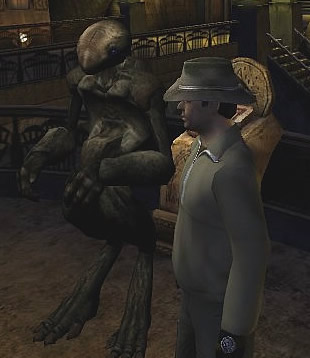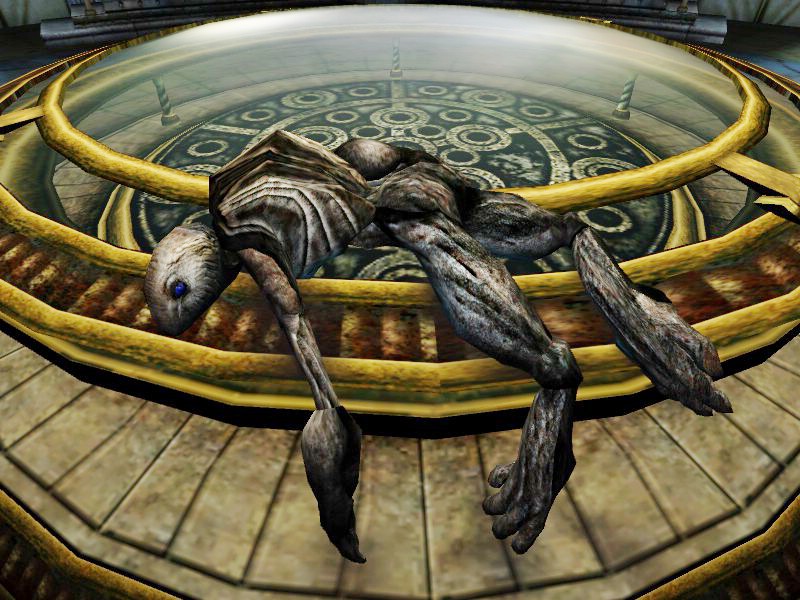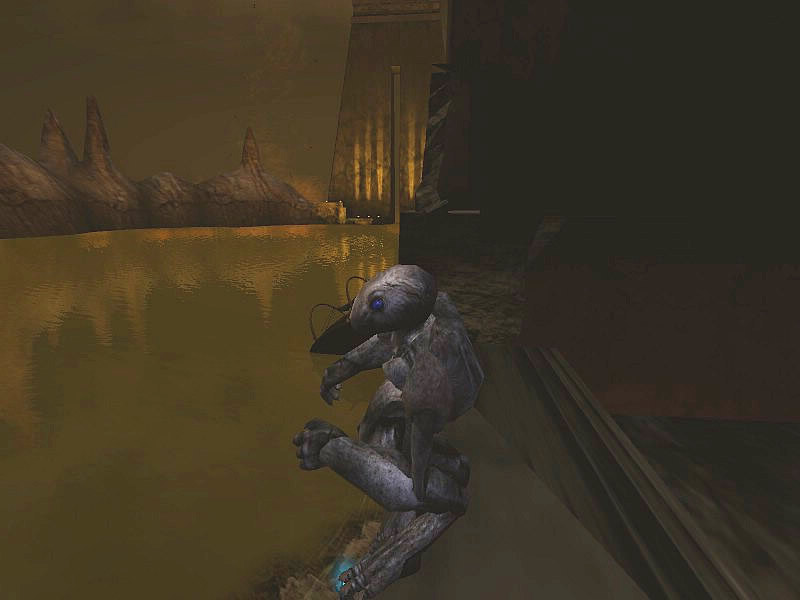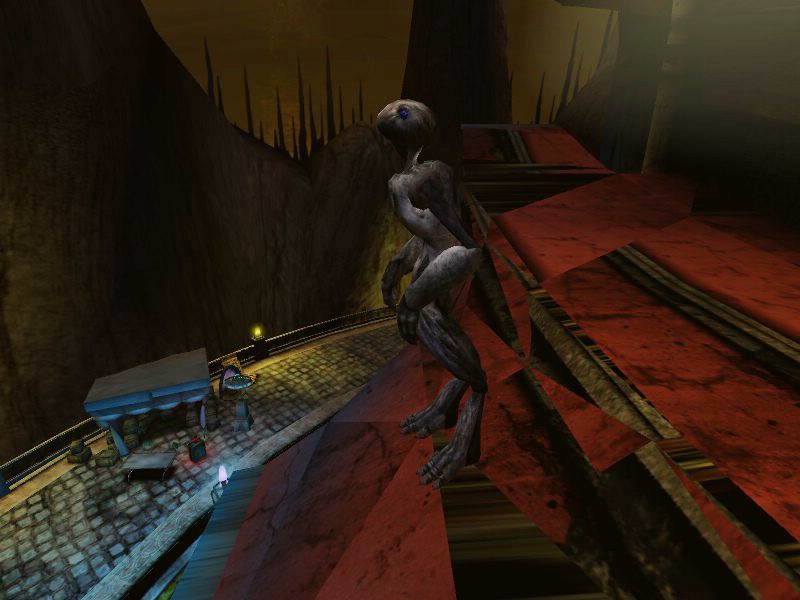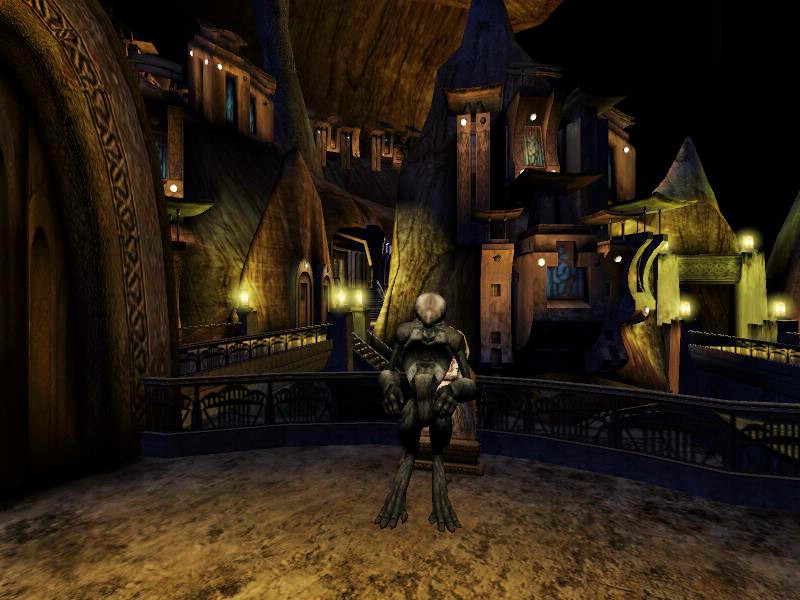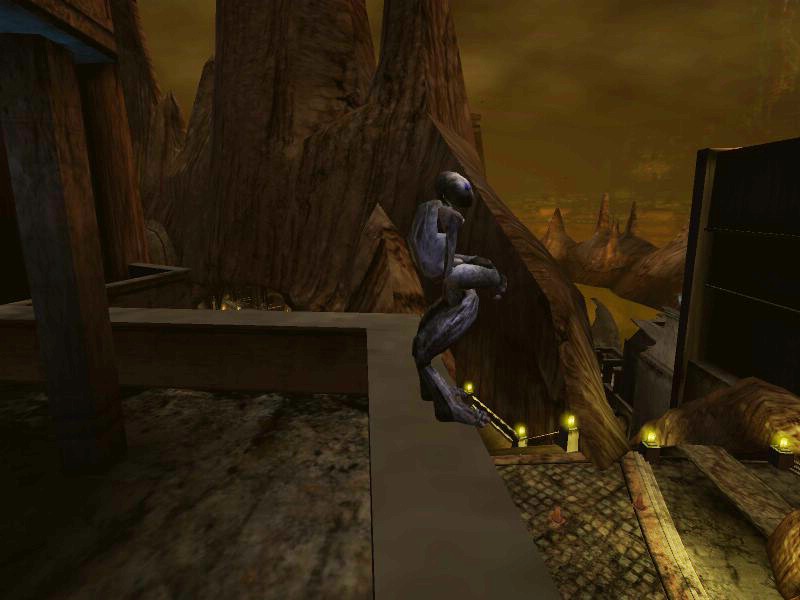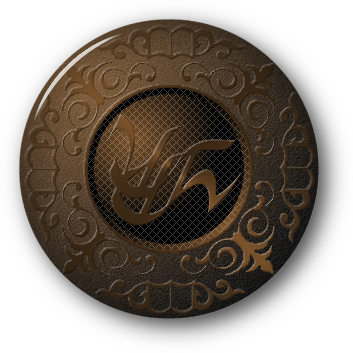

|
|
The word bahro is made up of two separate words in D'ni, "bah" ( ba ), which means "beast" or "animal", and "ro" ( ro ), which means "people". In D'ni, this name was applied to a specific nonhuman intelligent species who are suspected to be native to the Spiral Age. On the new Ronay home world, Terahnee, where they had become truly corrupt and arrogant, the word was used for any person of non-Ronay descent. The Bahro of the Spiral Age are very much a mystery. Very little is known of their society, culture, or psychology. Only Yeesha was able to communicate with them except through written symbols. At some point, she appeared to have gained the ability to hear them speak and understand what they were saying, although she replied to them in English or D'ni. Bahro are known to be highly intelligent, at the very least being equal to humanity in their abilities. It is not known where they normally live. They are the only people outside of the Ronay known to have developed the Art of linking, although it is not known if they ever wrote Ages. Like the Ronay, their Art is written, but instead of words, it uses symbols that can be drawn or tattooed on an individual. This gives them their ability to link from one place to another without need of books. They are also able to weave tapestries that function exactly like a linking book, which can be attached anywhere. Normally, they are attached to stone tablets, which we know as Bahro stones. Yeesha spent a period of time among them, and learned much about their Art. By combining the Bahro methods with those she had learned from her parents and from Calum, she was able to break rules of writing that the D'ni had long believed to be ironclad laws. Origin The origin of the Bahro is still unclear, although with the recent release of artists' sketches long held secret by the DRC, it appears that the Spiral Age is probably their true home. The Age contains many structures that appear to be sacred to the Bahro, and it has been rumored that the coming-of-age ceremony in which a young Bahro receives the ritual scars that allow them to link at will are held in an area there. It is evident that the Bahro possess a greater mastery of their version of linking than the D'ni. Because the term "bahro" could be considered derogatory, a group of explorers once proposed themore neutral vahkhro, meaning "linking people" should be used instead. This "politically correct" name never caught on. Characteristics and history Little is known of the culture and daily habits of Bahro, although that may change when and if exploration of the Spiral Age is ever permitted. It is known that they have a form of writing, and quite possibly a sophisticated language. However, other than a notable incident when the Bahro that murdered Wheely Engberg clearly and repeatedly said "Noloben", there are no known examples of hearing them speak anything recognizable as one. The chittering sounds they make when one is passing through one of their linking tunnels is the closest thing to it that has been recorded. This leads me to wonder if perhaps they are functional telepaths, and their language is spoken mentally rather than vocally. This theory arises from the fact that Yeesha has been seen to hold conversations with them, and the conversation is audible only on her side. Their diet in the caverns seems to consist of insects and grubs they catch, and are consumed without cooking. Bahro in the Age of Noloben developed a fear of a native snake, which is known as the tunnel snake because they are often found in caves and tunnels in that Age. It is not known why they fear the snakes so much, since the animals are harmless to humans. The Bahro fear of them is so intense that they will not only avoid any area that has snakes, they will avoid areas where there are old snake burrows and even any place where the Bahro's symbol for the snake is displayed. There is an old theory that the snake's venom might paralyze their linking abilities, but that is conjecture only. Bahro are noted for having painted numerous petroglyphs in a number of Ages. Among explorers, these rock paintings have the nickname "Bahrogyphs". The subjects of the glyphs tend to fall into three general categories; illustrations of Yeesha's personal history, illustrations of people and events significant to themselves, and illustrations of places or events Yeesha wanted to introduce to explorers. The main locations of the glyphs are Eder Kemo, inside the Cleft volcano caldera, and in Bahro Caves. There are other glyphs scratched into the inner surface of a large pipeline in Teledahn that are often attributed to the Bahro, but those were really scratched on the pipe by another race of intelligent non-humans. Several rumours about Bahro sightings in neighborhoods began circulating in March 2007. Around the 12th, a KI picture showing a lonely Bahro in a book room surfaced, proving the rumors to be true. More sightings occurred until one day dozens appeared around Ae'gura Island at once, flying in a cloud over the harbor near Kerath's Arch. Yeesha and the Bahro Yeesha discovered the Bahro while studying with her D'ni mentor, Calam. In her eighth journal found in the Great Shaft, she said:
After his death, she became obsessed with freeing the Bahro from their bondage to D'ni, and came up with a method of liberating them one by one, using Earth humans as a medium. An individual Bahro would call for a compatible human to come to the cavern, where he or she would be prompted to take a journey through specially modified instances of five D'ni Ages. The Bahro's soul was tied to four symbolic pillars that were stored in a cave dug into the ceiling of Rudenna, one of D'ni's residential caverns. The pillars would be charged during the journey, and then transferred to the person's instance of Relto. This somehow broke the bond of that particular Bahro had to the master tablet. Returning the pillars to the cave in Rudenna completed the process and the Bahro would be free to go where it wished to from that time onward. Yeesha, however, grew dissatisfied and angry at the progress of the plan. Not every person called would come, and not every person who came would complete the journeys. The rate at which the Bahro were being freed was slow, and the majority of them had no chance at all. This caused Yeesha to rant angrily about it in at least one recording she made in a viewer in an eder tomahn in the Great Shaft.
A golden tablet was used to enslave the Bahro. Yeesha claimed that the binding lasted over 10,000 years, although she did so in a moment of passion and relief when they were finally released, so the statement is suspect. The carvings on the Tablet appear to have both D'ni books and the pen emblem of the Guild of Writers, yet the Tablet itself seems to be Bahro technology. Yeesha wanted to possess the tablet with all her heart, but it turned out that it was for the wrong reasons. She wanted it to use its power to right the many perceived wrongs she saw around her, and that was a selfish motive. This caused her to be rejected.
In the end, it was Dr. Richard Watson of the DRC who unlocked the Tablet and selflessly gave it to the Bahro. By doing so, he broke the bonds they had to D'ni and gave them control over their own destiny. This proved to be both good and bad. Yeesha started him on the path to claiming the tablet, but said nothing of what he should do to avoid causing him to fail by her influence. Her rival claimant for the title of Grower, Esher, was more proactive.
Civil War In May of 2007 , Douglas Sharper was investigating the sharp decline in animal life in the Pod Ages, particularly in Negilahn. He discovered that he had been lured into a trap when he found himself surrounded by obviously hostile Bahro. He was only able to escape when another group of Bahro appeared and began fighting the Nekisahl. He returned to D'ni and stated that he'd witnessed a war. After being freed by Watson, it seems that the Bahro divided into at least two factions with oppsosing moral values. The hostile faction apparently felt that all humanity were to blame for their centuries of suffering, and were named the Bahro Nekisahl by Yeesha, meaning "twisted Bahro". An explorer named K'laamas suggested Bahro Shoraht, meaning "peaceful Bahro" for the faction that continued to follow Yeesha and who sometimes acted to protect humans from the vengeance of the Nekisahl. The Nekisahl were led by a Bahro that had been tortured on Noloben by Esher, who was attempting to learn how they were able to link at will. He was recognizable by the patch of missing hide where Esher had flayed him to steal his ability to link. Esher succeeded; he was able to link at will by using the hide which he wore draped over his shoulder, and the Bahro was never able to link again. He was forced to rely on his companions to take him where he wanted to go. It is thought that this was the Bahro that murdered Wheely Engberg after preventing her from linking out of the Tokotah II room where she'd been trapped by a cave-in. The Dead Bahro Douglas Sharper's encounter with the Bahro Nekisahl took place more or less at the same time Wheely Engberg and Rosette were caught in a cave-in in Tokotah II. After he escaped while the Nekisahl were fighting with the friendly Bahro faction, he went back and reported his encounter. Later, when Wheely was murdered, Sharper vowed to go back to Negilahn and kill the Nekisahl. He took a hunting rifle from his days stalking big game in Africa with him, and after a time found one of the Nekisahl there. However, just as he pulled the trigger, a friendly Bahro linked into the line of fire and the bullet struck it instead. The action appeared to be deliberate. Later, two Bahro brought the body of the one unintentionally killed by Sharper to the Great Tree Pub, and after standing watch over it for a time, left it there on display. The body eventually was taken away again, but not before many explorers had a chance to see it.
Wild Speculation As concrete information about the Bahro was lacking, wild guessing was common over the years since the cavern was opened. Did the Ronay and the Bahro once coexist on Garternay? That would explain how they could have been enslaved longer than D'ni existed. Were the Bahro the original inhabitants of the cavern? That would explain why they were bound there, instead of to Garternay. One imaginitive theory claimed that the Bahro were highly evolved descendants of the scarab beetle used in making ink because of their faint resemlance to insects and their seeming organic connection to the fabric of time and space. None of the early theories have proven true. Nevertheless, it's evident that the Bahro attained a deeper knowledge of the multiverse and thus a faction of D'ni decided to enslave them. Richard Watson of Cyan Worlds explained that it was because of their ability to move bulk cargo across dimensions, but it may also have at least partly been because the D'ni responsible resented that a race of beast like creatures were superior to them in their knowledge of the Art. It might even have been out of fear. Some have even speculated that the tablet was made by the Bahro to end a genocidal war they were losing against the D'ni, and the binding was a racial surrender. The Shouters There are perhaps four Bahro known as "shouters". Their screeching calls can be heard at intervals on Ae'gura Island and in the neighborhoods. It's not known why they call, although the one in the neighborhoods seems to have a correlation with people arriving by link. They have specific places where they link in, shout, and then link back out. However, the use of the term "they" must be taken with a grain of salt; the number of Bahro involved in shouting is unknown. It could be many more than four, or it could be just one. Since we cannot differentiate between individual Bahro, the exact number of individuals involved may never be counted. The shouters normally appear on rooftops, with the exception of the neighborhoods. The locations where they shout from are: The Ferry Terminal.
The Great Library.
The Neighborhoods.
The Palace.
Were the Bahro the victims of Rebek? This is a big question for a lot of explorers, because Yeesha went out of her way to imply that they were in her speeches, and she seems to have tried to deface a Bahro petroglyph in Eder Kemo that contradicted the story. It's one of those things that are probably just propaganda on Yeesha's part. There are several reasons why it's not likely to be true. First, Bahro tend to stand about five feet tall on average, and the chains in Teledahn seem to be for people who are much taller. Second, the bones found in the prison cage and in the prison in Gahreesen seem to be too massive for their bodies. Third, prison bars are not much use in restraining people who can link at will. Lastly, the Bahro didn't draw themselves in the Teledahn prison cave in their petroglyphs of it. Let's examine that last statement. Here are examples of how they drew themselves in petroglyphs. Some of the characteristics of their self-portrayals are rounded shoulders, short legs, hunched backs, and a symbol that looks like a weeping eye. That symbol was often included when they drew themselves, either on the figures, or nearby.
This is how they drew the prisoners in Teledahn. Notice the much longer arms and legs and the squared shoulders of these figures, and the lack of the weeping eye symbol they typically include somewhere around their self-portraits.
This is a petroglyh found in Teledahn, which appears to be a self-portrait by the prisoners there. The style bears no resemblance to the drawings made by Bahro, and shows two figures chained together at the ankles, and one manacled to an overhead chain.
|
|||||
Myst, the Myst logo, and all games and books in the Myst series are registered trademarks and copyrights of Cyan Worlds, Inc. Myst Online: Uru Live is the sole property of Cyan Worlds Inc. The concepts, settings, characters, art, and situations of the Myst series of games and books are copyright Cyan Worlds, Inc. with all rights reserved. I make no claims to any such rights or to the intellectual properties of Cyan Worlds; nor do I intend to profit financially from their work. This web site is a fan work, and is meant solely for the amusement of myself and other fans of the Myst series of games and books. |
